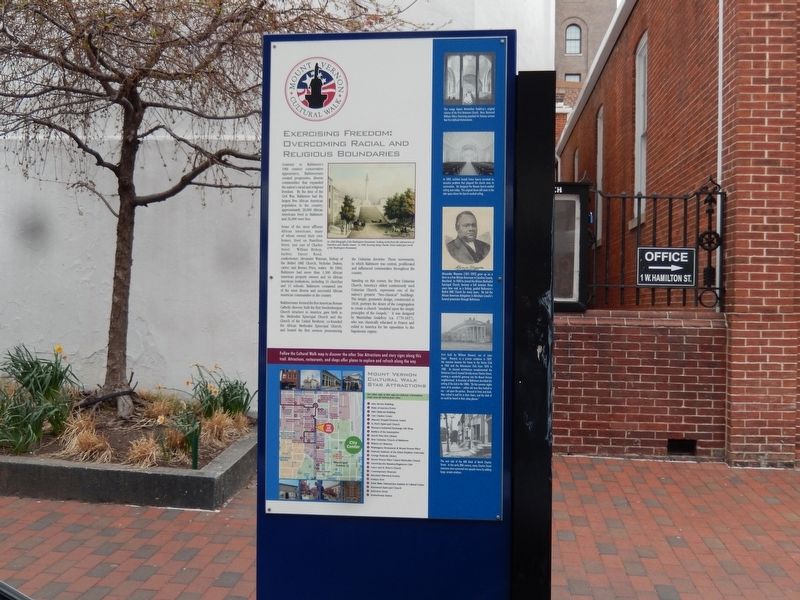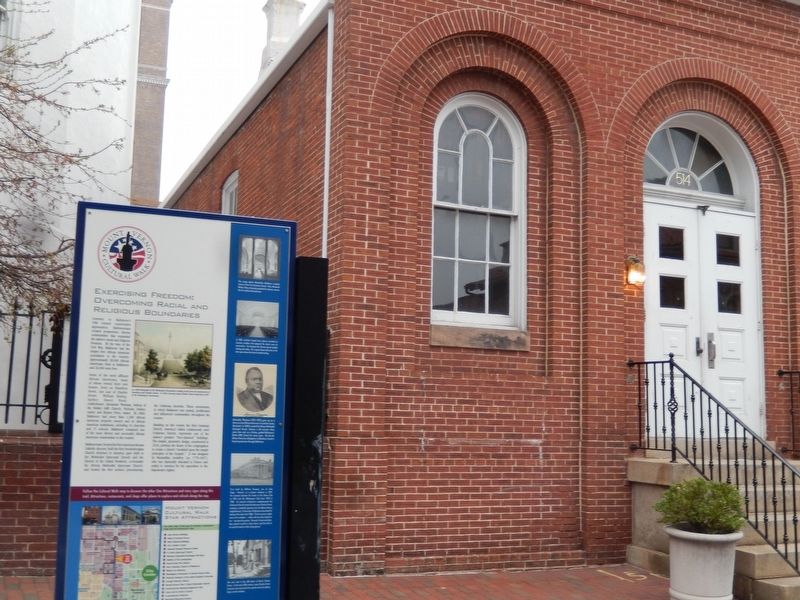Mount Vernon in Baltimore, Maryland — The American Northeast (Mid-Atlantic)
Exercising Freedom: Overcoming Racial and Religious Boundaries
Mount Vernon Cultural Walk
Inscription.
Contrary to Baltimore’s 19th century conservative appearance, Baltimoreans created progressive, diverse communities that expanded the nation’s racial and religious freedom. By the time of the Civil War, Baltimore had the largest free African American population in the country; approximately 28,000 African Americans lived in Baltimore and 26,000 were free.
Some of the most affluent African Americans, many of whom owned their own homes, lived on Hamilton Street, just east of Charles Street: William Bishop, barber; Emory Bond, confectioner; Alexander Wayman, bishop of the Bethel AME Church; Nicholas Dutton, carter; and Romeo Price, waiter. By 1860, Baltimore had more than 1,300 African American property owners and 44 African American institutions, including 16 churches and 15 schools. Baltimore contained one of the most diverse and successful African Americans communities in the country.
Baltimoreans formed the first American Roman Catholic diocese; built the first Swedenborgian Church structure in America; gave birth to the Methodist Episcopal Church and the Church of the United Brethren; co-founded the African Methodist Episcopal Church; and hosted the first sermon pronouncing the Unitarian doctrine. These movements, in which Baltimore was central, proliferated and influenced communities throughout the county.
Standing on this corner, the First Unitarian Church, America’s oldest continuously used Unitarian Church represents one of the nation’s greatest “Neo-classical” buildings. The simple, geometric design, constructed in 1818, portrays the desire of the congregation to create a church “modeled upon the simple principles of the Gospels.” It was designed by Maximilian Godefroy (ca. 1770-1837), who was classically educated in France and exiled to America for his opposition to the Napoleonic regime.
[Captions:]
An 1848 lithograph of the Washington Monument, looking north from the intersection of Hamilton and Charles streets. In 1848, housing along Charles Street ended just north of the Washington Monument.
The image depicts Maximilian Godefroy’s original interior of the First Unitarian Church. Here Reverend William Ellery Channing proclaimed his famous sermon that first defined Unitarianism.
In 1893, architect Joseph Evans Sperry corrected an acoustics problem that plagued the church since its construction. He designed the Roman barrel-vaulted ceiling seen today. The original dome still exists in the attic space above the barrel-vaulted ceiling.
Alexander Wayman (1821-1895) grew up on a farm as a free African American in Caroline County, Maryland. In 1840 he joined the African Methodist Episcopal Church, became a full minister three
years later and, as a bishop, guided Baltimore’s Bethel AME Church for many years. He led the African American delegation in Abraham Lincoln’s funeral procession through Baltimore.
First built by William Howard, son of John Eager Howard, as a private residence in 1829, the mansion became the home to the Union Club in 1863 and the Athenaeum Club from 1878 to 1908. Its classical architecture complemented the Unitarian Church located directly across Charles Street, creating a wonderful gateway into the Mount Vernon neighborhood. A chronicler of Baltimore described the setting of the club in the 1880s; “On hot summer nights some of its members-rather old men they looked to me—sat upon the portico. Dressed in linen and duck, they rocked to and fro in their chairs, and the clink of ice could be heard in their julep glasses.”
The east side of the 600 block of North Charles Street. In the early 20th century, many Charles Street mansions were constructed into upscale stores by adding large, ornate windows.
Topics and series. This historical marker is listed in these topic lists: African Americans • Arts, Letters, Music • Churches & Religion. In addition, it is included in the African Methodist Episcopal (AME) Church, and the Unitarian Universalism (UUism) series lists. A significant historical year for this entry is 1860.
Location. 39° 17.731′ N, 76° 36.937′ W. Marker is in Baltimore, Maryland. It is in Mount Vernon. Marker is at the intersection of North Charles Street and Hamilton Street on North Charles Street. Touch for map. Marker is in this post office area: Baltimore MD 21201, United States of America. Touch for directions.
Other nearby markers. At least 8 other markers are within walking distance of this marker. The First Unitarian Church of Baltimore (within shouting distance of this marker); a different marker also named The First Unitarian Church of Baltimore (within shouting distance of this marker); Pope John Paul II Monument (about 300 feet away, measured in a direct line); Walters Art Museum (about 400 feet away); Expanding the American Intellect: Icons and Iconoclasts (about 400 feet away); Memorial To Edward Berge (about 500 feet away); George Washington Bicentennial Marker (about 500 feet away); 23 East Centre Street (about 500 feet away). Touch for a list and map of all markers in Baltimore.
Credits. This page was last revised on March 23, 2024. It was originally submitted on March 29, 2017, by Don Morfe of Baltimore, Maryland. This page has been viewed 260 times since then and 17 times this year. Photos: 1, 2. submitted on March 29, 2017, by Don Morfe of Baltimore, Maryland. • Bill Pfingsten was the editor who published this page.

